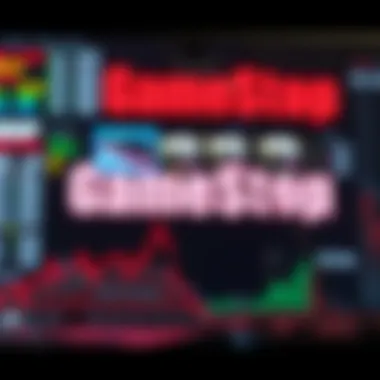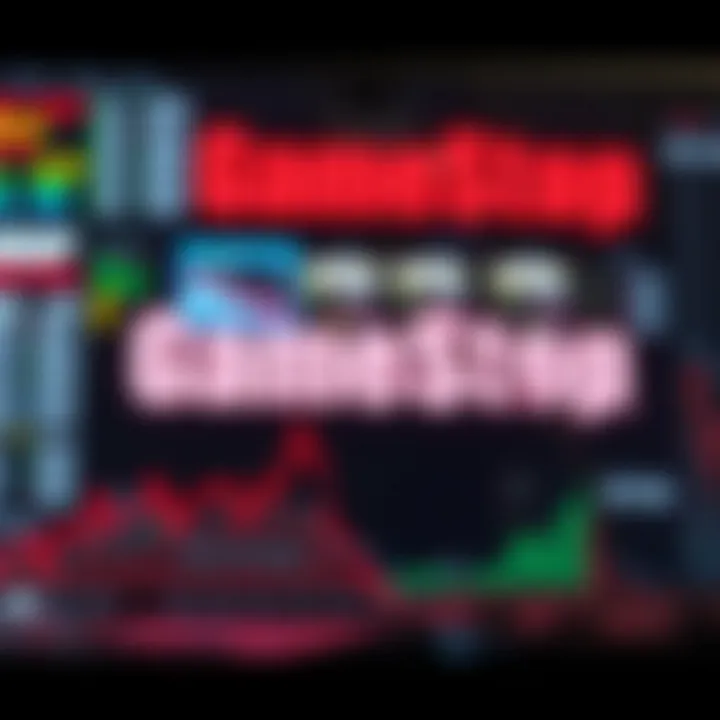GameStop Stock Analysis: Patterns and Future Insights


Intro
The GameStop saga has captured the attention of investors and analysts alike, sparking conversations that ripple through Wall Street and beyond. As the stock price soared from mere dollars to astronomical figures, a blend of market phenomena, consumer behavior, and social media frenzy moved the needle. Understanding the journey of GameStop stock helps not just in grasping the past, but also in navigating the future of investment in a digital age.
In this article, we will delve into the intricate web of factors that have defined GameStop’s valuation. Through exploring price movements, trading volumes, and market indicators, we aim to equip investors and traders with the knowledge needed to make informed decisions. The insights garnered from historic patterns can shed light on potential future trends in both stock and broader cryptocurrency markets.
Our analysis will cover the most critical elements that led to the extreme volatility surrounding GameStop. We will closely examine investor psychology, behavioral finance aspects, and how social media platforms have altered the landscape. By providing a comprehensive understanding of these dynamics, we wish to arm our readers with the tools necessary for developing robust trading strategies.
Let’s first explore the fascinating world of market trends, focusing on the patterns that are currently shaping the cryptocurrency landscape.
Market Analysis
Current Trends in Cryptocurrency
The cryptocurrency space is swirling with activity, presenting both opportunities and challenges. New projects emerge daily, and the landscape evolves with unprecedented speed. Some of the current trends catching the eyes of traders include:
- Decentralized Finance (DeFi): DeFi continues to gain traction as it promotes financial independence without depending on traditional banks. Applications of DeFi platforms are expanding, offering everything from lending to yield farming.
- Non-Fungible Tokens (NFTs): NFT markets are flourishing as digital ownership becomes a cultural phenomenon. The blending of art and technology has pushed NFT trading to new heights.
- Institutional Investment: Growing interest from institutional investors has elevated the profile of cryptocurrencies. Major firms are investing and providing services within this space, indicating a shift toward mainstream acceptance.
With these trends, understanding the time frames of investments becomes crucial.
Price Prediction Techniques
When it comes to predicting price movements in the volatile world of cryptocurrency, various techniques have garnered attention. Here are a few methods that experienced traders utilize:
- Technical Analysis: Traders often leverage charts, historical price data, and indicators to make educated decisions. Common tools include Moving Averages, Relative Strength Index (RSI), and Fibonacci retracement levels.
- Sentiment Analysis: This technique gauges market mood through social media, news, and broader communication platforms. Platforms like Reddit have shown the power of collective sentiment in influencing stock prices.
- Fundamental Analysis: For long-term investors, evaluating the underlying value of a cryptocurrency—its technology, team, and use-case—offers insight beyond short-term price swings.
These techniques can provide insightful perspectives and help navigate the turbulent waters that GameStop and cryptocurrencies sail upon.
Next, we will outline various investment strategies that can be pivotal in approaching trading with confidence and nuance.
Foreword to GameStop and Its Significance
The unfolding saga of GameStop stock is not just a financial tale but rather a cultural phenomenon that highlights the shifting landscape of retail investment. In the wake of unprecedented events surrounding the stock's meteoric rise, understanding the intricate details of GameStop's journey becomes paramount. It serves as a case study that marries market dynamics with social movements, capturing the interest of investors, analysts, and the public alike.
Understanding GameStop's Business Model
At its core, GameStop operates as a retailer of video games, consoles, and related merchandise. Traditionally, the company’s model revolved around brick-and-mortar stores, where customers could purchase, trade, or rent video games. However, as industry dynamics shifted towards digital game distribution and online purchases, GameStop had to navigate precarious waters.
In recent years, GameStop sought to adapt its strategy by embracing e-commerce and exploring diversification into new technology ventures. Despite its struggles against digital competitors like Steam and the shift away from physical retail, GameStop remains emblematic of a nostalgic past for gamers. The potential for transformation drew both critique and admiration from various sectors of the market, leading to diverse opinions on its viability in an increasingly digital world.
The Role of GameStop in Retail Investment Culture
The significance of GameStop transcends its role as a retailer. It has become a symbol within the retail investment culture, embodying the clash between individual investors and institutional players. The stock's surge in early 2021 was fueled by vibrant communities on platforms like Reddit, where small investors rallied together against hedge funds looking to short the stock.
This cooperation reflected a broader shift in investment strategies, where many everyday investors began to view themselves as stakeholders in a common cause, rather than passive participants in the market. This 'David vs. Goliath' narrative captivated the imaginations of many, ultimately reshaping conversations around market manipulation and regulatory frameworks.
"GameStop's rise from a struggling retailer to a battleground for retail investors underscores a seismic shift in how individuals engage with the stock market".
Understanding GameStop's significance requires examining not just the numbers but also the emotional sentiments driving investor behaviors. The interplay between nostalgia for gaming culture and the burgeoning call for democratization in trading reflects a complex and evolving narrative.
In essence, analyzing GameStop is more than just looking at stock prices. It’s a multilayered story about resilience, community, and the future of investing.
GameStop Stock: Historical Context
The examination of GameStop's stock within its historical context reveals a narrative not just about numbers, but the interplay of market forces and investor behavior. Understanding this background is crucial, as it sets the scene for the remarkable events that unfolded, capturing the attention of both seasoned professionals and casual investors. Several elements make this exploration significant.
Firstly, historical trends often serve as a road map. They provide context that helps investors anticipate potential future movements in stock prices. The GameStop saga is a prime example, showcasing how past performances can signal shifts in market sentiment or economic conditions. Importantly, by diving deep into the events that shaped GameStop's stock trajectory, investors can bolster their trading strategies with information that transcends mere speculation.
Additionally, recognizing the confluence of external factors at play, such as economic downturns, shifts in consumer behavior, and technological adaptations, gives investors a broader understanding of how such elements can affect stock valuations. GameStop's journey isn't isolated; it's influenced by a myriad tapestry of dynamics, making such analysis vital for grasping the full scope of what transpired.
Finally, considering GameStop within its historical landscape allows for a nuanced appreciation of market psychology. Understanding how investor sentiment has fluctuated over time elucidates why prices surged or dipped, potentially providing valuable insights for future trading.
Early Trading Patterns Before the Surge


Before the meteoric rise of GameStop's stock, trading patterns displayed a certain predictability. Up to the early part of 2020, GameStop traded mainly within a narrow range and exhibited moderate volatility. The stock often hovered around the $5 to $10 mark, reflecting the overwhelming perception of the company as a fading retailer in a digital age, beleaguered by the rise of gaming downloads.
During this period, trading volumes were rather subdued, with daily exchanges not attracting heavy attention. The stock's performance relied on consistent sales figures that, unfortunately, began to slump as gamers shifted towards online purchases. Despite these trends, a committed cadre of long-term investors remained hopeful, believing in the potential turnaround of the business model and the revival of brick-and-mortar stores post-pandemic.
The picture painted by this era may seem bleak, yet it formed the foundation for the dynamic shift that was about to occur. Traders often look closer at these consistent trading patterns, recognizing that there's always something lurking beneath the surface, waiting to erupt — a classic case of "calm before the storm."
Key Events Leading Up to the Stock Surge
The events preceding the huge stock surge of early 2021 would become a textbook case for modern trading dynamics. Several key moments helped kindle the fire that ignited GameStop’s unprecedented climb.
- The Announcement of Short Selling: GameStop became one of the most shorted stocks on the market. These short sales depicted a growing belief among institutional investors that the company would fail. They borrowed shares, betting against the stock, thus laying the groundwork for the ensuing chaos.
- The Rise of Retail Investors: The emergence of platforms like Robinhood enabled ordinary investors to buy and sell shares easily and without commission fees. This democratization of trading sparked a significant uptick in retail investor activity. Retail investors began to see the potential for a David-and-Goliath scenario, rallying behind GameStop to challenge institutional players.
- The Power of Social Media: Platforms like Reddit’s WallStreetBets gathered momentum. Conversations about GameStop shifted from casual discussions to a rallying cry, viral posts pushing the stock into the limelight almost overnight. Gamers and retail traders united, fueled by a sense of empowerment that stemmed from collective action.
- Media Attention: As the stock began to gain traction, media outlets picked up on the stories, further amplifying public interest. Headlines and discussions about GameStop filled news broadcasts, igniting unprecedented demand and inflating prices.
Each of these catalysts contributed to a frenzy that defied conventional market behaviors, elevating GameStop to a household name and reshaping perceptions about assets, trading, and the everyday investor's ability to shake the very foundations of Wall Street.
In summary, the historical context surrounding GameStop stock not only provides a backdrop for understanding its dramatic volatility but also serves as an astute reminder of the intricate tapestry of human behavior, market mechanics, and technological evolution. Narrative-driven insights lay the groundwork for investors aiming to navigate the ever-changing waters of market sentiments.
The Metamorphosis of GameStop Stock
The game surrounding GameStop stock can be likened to a rollercoaster ride that��’s been both thrilling and bewildering. It’s essential to pin down the metamorphosis of this stock because it showcases how traditional investment norms can be tossed out the window in a digital age where information spreads faster than wildfire. Not only did it demonstrate the power of collective investor actions, but it also forced a reconsideration of concepts like market manipulation, retail investor influence, and stock valuation.
Analyzing the Stock Surge in Early Twenty-Twenty-One
In the early months of twenty-twenty-one, GameStop's stock price began to shoot upward, much like a rocket bound for the stars. What was once seen as a struggling retail entity transformed into a focal point for unprecedented trading activities. The surge can largely be attributed to the mobilization of retail investors, primarily through Reddit’s r/WallStreetBets forum. These investors banded together, pushing one another to buy shares and hold rather than sell, a strategy that ignited a short squeeze against institutional investors who had heavily shorted GameStop.
The stock, which previously had a price stagnating in the single digits, skyrocketed to over $400 at its peak. This didn’t just catch the eyes of financial analysts but sent shockwaves through the trading platforms, many of which struggled to keep up with the frenzied transactions.
Key factors surrounding this surge include:
- Community Dynamics: The sense of camaraderie among investors encouraged more participation, strengthening their resolve to hold the stock.
- Media Attention: The press caught wind of the phenomena, offering a dual-edged sword. It brought more investors into the fray, but it also drew scrutiny from regulators.
- Market Sentiment: The overall sentiment in the market shifted; doubt turned into a cautious optimism for retail investors, prompting many to question other narratives about institutional power.
The magnitude of this rise isn’t just a figure on a chart; it redefined how retail engagement with Wall Street could unfold.
Volume and Volatility: The Trading Frenzy
The trading frenzy accompanying GameStop stock became a case study in volume and volatility. Picture a game of tug-of-war – one side pulling with outrageous volume while the other struggled desperately to hold their ground. The stock traded millions of shares each day, overwhelming traditional trading algorithms and exposing the market to extreme volatility.
At one point, GameStop witnessed an astounding intraday price swing from around $100 to $300, before eventually settling lower as volatility took its toll.
Several key elements to note include:
- Increased Retail Participation: Trading platforms like Robinhood saw a sharp rise in users as many entered the market looking to strike while the iron was hot.
- Margin Calls and Restrictions: Many retail traders experienced margin calls when prices began to swing dramatically, while some platforms had to restrict trading to maintain liquidity.
- Algorithmic Trading Influence: High-frequency trading algorithms jumped in, exacerbating the volatility by rapidly buying and selling, which only added another layer of uncertainty.
"The frenzy illuminated an unprecedented dynamic in trading, where retail investors could rally to challenge the institutional norm."
The volatility of GameStop shares, due to this trading frenzy, not only shook the foundations of traditional investment strategies but also opened up a broader conversation on the role of technology in modern markets. This shift indicates that the metamorphosis of GameStop stock is more than just statistics; it represents a cultural and structural change in how we understand stock trading, rooting out complex behaviors and reactions among investors.
Key Indicators in GameStop's Stock Chart Analysis
Understanding the key indicators in GameStop's stock chart analysis is crucial for investors and traders alike. These indicators not only offer insights into past market behavior but also help in predicting future trends. As the market environment can shift like sand, grasping these charts is akin to having a compass in uncharted waters. This analysis will explore various elements that play a pivotal role in stock movements, the benefits they provide, and considerations to keep in mind during evaluation.
Technical Analysis Tools Utilized
Technical analysis relies heavily on various tools that dissect price movements and trading volumes. Investors deploying these methods typically focus on several key instruments:
- Moving Averages: These smooth out price data to identify trends over specific periods. Short-term moving averages can signal potential buy or sell points when they cross with long-term averages, often referred to as 'crossovers.'
- Relative Strength Index (RSI): This measures the speed and change of price movements. If GameStop’s RSI reaches extreme levels—either above 70 or below 30—it can suggest overbought or oversold conditions, prompting traders to reconsider their positions.
- Bollinger Bands: These depict volatility and potential price levels. The closer the price nears the upper band, the more overbought it may appear, while nearness to the lower band may indicate oversold conditions.
When these tools are combined with a fundamental understanding of market behavior, they offer a roadmap that can lead traders successfully through turbulent waters.
Support and Resistance Levels Observed
Support and resistance levels are two of the most significant concepts in charting GameStop’s stock performance. These levels represent points where the stock price tends to halt and reverse due to buying or selling pressure. Here’s how they function:
- Support Levels: These are price levels where buying interest is consistently strong enough to prevent the price from falling further. They often represent entrenched investors believing in GameStop's long-term prospects. Identifying these levels can indicate strategic entry points for new investors.
- Resistance Levels: Conversely, resistance levels act as ceilings where selling interest is robust enough to push back against upward movements. Observing when GameStop reaches these levels can provide traders with clues about potential reversals or consolidations.


In practice, effective investors keep a close watch on these levels. They often use them to structure trades, ensuring they're entering the market at points of technical validation, thus minimizing potential risks while maximizing opportunities.
Remember, a well-charted map of GameStop stock—and the markets in general—can inform trading decisions that improve outcomes significantly.
Navigating the complexities of stock chart analysis is no small feat. However, familiarity with these indicators can empower investors, paving paths toward more informed and strategic trading decisions.
Psychological Factors Influencing Investors
The psychological elements at play in the trading world are often as crucial as any financial indicator. Investor psyche can impact stock movements in a manner that's not immediately evident from charts or graphs. This section will shed light on the psychological factors that shape investor behavior, emphasizing the need to understand more than just market mechanics when analyzing trends like those seen in GameStop's stock. The two main psychological drivers driving this phenomenon include herd mentality and the fear of missing out.
Herd Mentality and Its Impact on Trading Decisions
In an era where information spreads faster than wildfire, herd mentality can be a double-edged sword. This phenomenon occurs when investors follow the actions of a majority rather than relying on their own analysis. The emotional appeal behind this behavior is clear: if everyone else is making money, why shouldn’t I?
GameStop’s stock surge in twenty-twenty-one is a prime example of herd mentality. The regularities of the stock price weren't driven solely by fundamental analysis but by a collective decision-making cascade fueled by social media chatter and community discussions. The Reddit community around WallStreetBets played a pivotal role in amplifying this trend. Poor investment decisions based on social pressures can lead to significant financial losses. When too many are tipping their hats in the same direction, it can create a false narrative that eventually leads to an abrupt price correction.
"The number of traders willing to jump on a bandwagon underscores the human instinct to seek reassurance from the crowd."
As more investors clambered aboard the GameStop bandwagon, it became evident how quickly a stock could balloon. If you're an investor, you don't want to be the last one out the door when the music stops. Therefore, recognizing the signs of herd mentality at play is crucial for making sound trading decisions.
Fear of Missing Out: Analyzing Investor Behavior
Fear of missing out, commonly referred to as FOMO, has become the specter overshadowing many investment choices. This instinctual fear can drive bull markets to dizzying heights but also serves as a siren call to misguided traders who end up chasing losses.
When GameStop began its unexpected surge, many investors felt compelled to jump into the fray due to FOMO. Stories of average investors making significant gains circulated widely across platforms like Twitter and Reddit. This created an environment where rational decision-making took a backseat, and emotional impulses drove trades.
Investors need to understand how FOMO can skew their judgments. It's essential to have a strategy in place. Instead of reacting to price changes fueled by social media hype, consider sticking to a pre-planned strategy could shield an investor from pitfalls. The clarity of mind can sometimes be worth more than the allure of quick profits.
In summary, psychology plays a significant role in the trading landscape. Recognizing how factors like herd mentality and FOMO weave together gives investors a richer perspective on market behavior, particularly in notorious cases such as GameStop's stock. By keeping these elements in mind, traders can better navigate the complexities of their decisions and potentially increase their long-term viability in an unpredictable market.
The Intersection of Social Media and Trading
In today's rapidly moving financial landscape, the influence of social media cannot be understated, especially when it involves specific stocks like GameStop. The blend of retail investment with platforms such as Reddit and Twitter has reshaped how traders engage with the market. It is here that we see a convergence of anecdotal enthusiasm and collective intelligence, impacting decisions in real time and stirring volatility in stock prices. Trading today isn't just about charts and economic reports; a tweet or a subreddit post can send shares soaring or crashing.
Reddit and the GameStop Phenomenon
Reddit played a pivotal role in the recent saga surrounding GameStop. The subreddit WallStreetBets became an unlikely hotspot for retail investors who shared tips, strategies, and opinions on GameStop stock. A tight-knit community of users rallied together to buy shares and options, creating an unprecedented short squeeze in January 2021 that caught many hedge funds off guard.
The beauty of this phenomenon lies in the democratic nature of Reddit. Users from all walks of life, armed with varying degrees of financial knowledge, participated in the conversation. A post highlighting a potential undervaluation could lead to a wave of buying, all driven by the collective sentiment of the forum. This environment nurtured a sense of camaraderie and even a bit of rebellion against traditional investment norms.
Furthermore, Reddit provided a platform for transparency. Users shared screenshots of trades and gains, instilling confidence among members. Even those new to investing might have felt emboldened by seeing others' successes. The aggregation of opinions and strategies on this forum helped turn GameStop from a struggling brick-and-mortar retailer into a symbol of retail investor empowerment.
Twitter Dynamics and Stock Movement
Twitter's influence on market dynamics is equally compelling. The platform serves as a lightning-fast outlet for the latest news and trends, making it a vital tool for real-time trading decisions. Influential figures, sometimes dubbed "finfluencers," can sway investor sentiment simply by tweeting opinions or sharing insights about GameStop or similar stocks.
Hashtags like #GameStop and #ShortSqueeze trended extensively during the peak activity periods, creating a buzz that easily crossed into mainstream media. This sort of visibility encouraged more traders to jump in, often without detailed analysis, driven by fear of missing out—or FOMO—on potential gains.
Moreover, Twitter allows for a level of immediacy that traditional news outlets simply cannot match. Traders can share quick updates about price movements or breaking news, leading to swift reactions within the market. Combined with Reddit’s in-depth discussions, these platforms create a duality in the information-sharing landscape that contemporary traders must navigate.
To summarize, the intersection of social media and Trading, particularly in the case of GameStop, demonstrates a fundamental shift in how people engage in the stock market. What once was a realm dominated by institutional investors is increasingly influenced by everyday consumers, utilizing platforms they connect with on a personal level. As the lines between social interaction and financial activity blur, the implications for future investment strategies are profound. Therefore, understanding these dynamics is essential for anyone looking to navigate the complex waters of modern trading.
"The democratization of trading via social media is both a blessing and a curse, reshaping the landscape in ways that can be unpredictable and potent."
For more on social media's impact on finance, you can check out resources from Investopedia, Britannica, and the bustling community on Reddit.
Regulatory Responses and Market Implications
The recent trading saga of GameStop has ushered in a wave of scrutiny from various regulatory bodies. This scrutiny is not just a reaction to the volatility observed in its stock but signifies a larger conversation about the intersection of technology, investing, and regulation. The importance of discussing regulatory responses and their implications cannot be overstated. It provides investors with insights into how changes in the law can shape trading environments and influence market behavior.
Analyzing Regulatory Changes Post-Surge
After the surge in GameStop's stock price, regulators were quick to jump into action. This included the Securities and Exchange Commission (SEC), which announced intentions to review market regulations regarding short selling and trading behaviors influenced by social media.


The primary focus was on the mechanisms that made such rapid movements in stock prices possible. Several key aspects were highlighted:
- Increased Oversight: Regulators began to enhance their watchful eyes on trading platforms and brokerages. This raised questions of market manipulation and the transparency of the processes in place.
- Short Selling Regulations: GameStop's quick ascent was partly attributed to a high level of short selling. Some regulators hinted at potential adjustments to existing policies to prevent similar occurrences in the future.
- Rapid Technological Advancements: With the rise of trading apps like Robinhood, which allowed for immediate buy and sell actions, regulators realized they need to adapt to an environment dominated by technology and rapid transactions.
The conversations around these topics have been crucial in shaping future investment strategies and could lead to a more robust framework for protecting investors and ensuring market efficiency.
Market Reactions to Regulatory Scrutiny
When the news of potential regulatory changes first broke, market reactions were swift and varied. Investors, traders, and analysts responded to hints at new laws and investigations with a mix of anxiety and curiosity.
"The stock market isn’t just influenced by figures and charts; it's also a realm of emotions, strategies, and regulations that shape investor confidence."
Key points of market reaction included:
- Volatility in Stock Prices: Following news of regulatory changes, GameStop’s stock and those of similar companies experienced erratic price fluctuations. The uncertainty around regulation led many investors to question their positions, resulting in a domino effect on trading volumes.
- Heightened Awareness: Investors began to educate themselves about the implications of regulation on their trading strategies. Forums and financial news outlets saw increased engagement, with discussions surrounding how to navigate a possibly more restrictive market.
- Impact on Trading Strategies: Many traders began recalibrating their strategies, with some opting to pivot towards more established stocks rather than high-volatility securities. The prospect of regulatory measures made investors cautious as they awaited clearer guidelines.
The ongoing discussions about regulation highlight the fragility of investor confidence in uncertain times. How the regulatory landscape evolves in response to situations like that of GameStop's stock will likely be a cornerstone in market dynamics for years to come.
For further understanding of regulatory frameworks, you can explore these resources:
Regulatory responses to the GameStop phenomenon not only underscore the importance of oversight but also signal a transformative period in finance where technology and market behavior will continually push the boundaries of regulation.
Future Outlook for GameStop Stock
The horizon for GameStop stock is a melting pot of potential, holding the key to various investment strategies and future market dynamics. As the dust settles from the trading frenzy seen in early 2021, both analysts and casual investors find themselves pondering the trajectory of GameStop’s stock in the coming years. Understanding its future is not simply about numbers and graphs; it’s also about the broader implications of the investment landscape itself. This section aims to distill the vital elements for considering GameStop's future.
Evaluating Long-Term Viability
When evaluating the long-term viability of GameStop's stock, it’s essential to recognize its shifting business model. Traditionally a brick-and-mortar retailer, GameStop has shown resilience by embracing e-commerce. Furthermore, the company's efforts to innovate its service offerings, like expanding into gaming-related digital products, are signals that it doesn't intend to fade away quietly.
Investors should keep an eye on financial health indicators, such as:
- Earnings reports: Trend lines in revenue growth will reveal whether the company's initiatives are paying off.
- Debt Levels: Managing debt is crucial for long-term sustainability. Elevated debt levels can hinder flexibility in strategic decisions.
- Market Trends: Understanding how consumer preferences shift – particularly towards online sales in gaming – will be critical.
In a nutshell, assessing factors like market adaptability and financial resilience will be central to determining whether GameStop can retain a foothold in the competitive gaming landscape.
Potential for Cryptocurrency Integration
Cryptocurrency is not just a buzzword anymore; it’s becoming a cornerstone in many financial conversations, including stock trading. For GameStop, the potential for cryptocurrency integration offers an intriguing avenue worth exploring. Picture a scenario where the company could facilitate transactions via digital currencies, perhaps even offering discounts for cryptocurrency payments inside their stores or online.
The intersection of gaming and cryptocurrency can provide:
- Increased Customer Engagement: Gamers are increasingly tech-savvy. A cryptocurrency option could attract a crowd that’s already invested in digital finance.
- NFT Opportunities: Non-fungible tokens have surged in popularity. GameStop could develop a marketplace for gamers to trade game-related assets, thus merging two potent trends.
- Diversified Revenue Streams: By embracing digital currencies, GameStop could see fresh inflows of revenue, particularly in a landscape where consumer spending preferences are shifting rapidly.
Over the next few years, the ability to adapt to new technologies like cryptocurrency could split the winners from the losers in the retail investment game.
Epilogue
The conclusion of this analysis serves as a cornerstone for understanding the evolving narrative of GameStop stock. Throughout this article, we’ve dissected its meteoric rise and fall, while considering the myriad of factors at play in a retail investment landscape that is more dynamic than ever. Recognizing the significance of each piece — from historical trends to investor psychology — allows for a nuanced comprehension of why GameStop became a symbol of modern trading phenomena.
Summarizing the GameStop Stock Journey
The journey of GameStop stock has been anything but ordinary. Starting as a mere brick-and-mortar gaming retailer, it transformed into a focal point for discussions around market manipulation, investor activism, and speculative trading. In early 2021, what began as a grassroots movement among retail investors gave rise to unprecedented price surges fueled by social media platforms, particularly Reddit’s WallStreetBets. The trading frenzy that ensued illuminated the fragility of traditional market structures and highlighted the power of collective action.
Notably, the stock's performance was not merely a product of its business fundamentals—or lack thereof—but also influenced by psychological factors such as the fear of missing out and the contagious nature of herd mentality. This interplay of speculative trading and investor sentiment provided invaluable insights into how modern investors engage with the market.
In a nutshell, the rise and subsequent volatility of GameStop stock acts as a case study on how financial ecosystems can shift dramatically in the digital age.
Implications for Future Investments
Looking ahead, the implications of GameStop’s saga are significant. Investors and analysts alike must reconsider their strategies in light of this event. The blending of retail and institutional investment, propelled by social media and online forums, indicates a seismic shift in how stocks are viewed and traded. As companies increasingly operate in the digital domain, they cannot afford to ignore the implications of online communities and trends when considering their market position.
Moreover, regulatory bodies are likely to keep a sharper eye on such market movements, potentially leading to altered governance practices and trading regulations in the future. Investors would be wise to remain cognizant of the evolving landscape and consider incorporating a more holistic view into their investment strategies.
"The tale of GameStop isn't just about the highs and lows of a stock; it’s a testament to the power of collective action in a digital age."
For those intrigued by the intricate details of the GameStop saga, further readings can be found on Wikipedia or Britannica.
Additionally, engaging with the discussions on Reddit can provide ongoing insights into market trends and investor sentiment.















